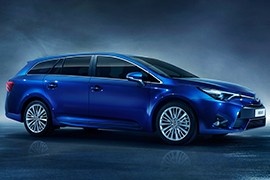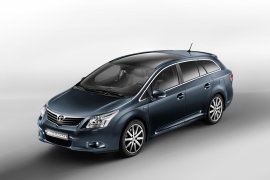
TOYOTA Avensis Wagon
Generations Timeline, Specs and Pictures

The upgraded Avensis differed a lots from the model it replaced, offering two new engines borrowed from BMW.
The exterior design was refreshed, all the panels were new and LED running lights were included.
While it was built on the same platform, the interior was redesigned. The cockpit looked familiar, but slightly changed with tunnel dials and an LED coloured display with several functions including safety features and sat-nav.
The biggest 8-inch touchscreen display could be controlled by touching, of course, and by using the physical buttons.
The center console was also refreshed, still offering the same single cup holder and another cupholder placed under the armrest, not the most efficient place to mount it if you ask me.
The plastics used were of good quality, however, easily scratchable.
The rear seats passengers could easily enjoy journey with the decent legroom and headroom, as well as a child in the middle seat would be comfortable due to the flat floor in the middle.
With great room for passengers and a decent cargo space, the Avensis also had a good fuel consumption. As it was designed for mostly motorway journeys, the Avensis could take 5 L/100 km. Not bad at all!

Boasting Toyota’s Vibrant Clarity design language, the Avensis Wagon addresses a well defined market segment, offering increased loading space and multi-purpose functionality with clearly unconventional looks.
While the fashion tastes are always subjective, we cannot admit the estate’s aggressive design. The large and blocky tail lights emphasize the car’s aggressive looks perhaps a bit too much, but sets it apart none the less. With a drag coefficient of just 0.29, the estate model benefits from Toyota’s Optimal Drive technologies as well, returning top-of-the-segment fuel consumption.

The second-generation Toyota Avensis was launched in 2003 and in 2004 was already receiving the title of the European Car of the Year.
In 2007, Toyota introduced a refreshed version of the Avensis, with updates regarding its exterior design, as well the addition of a new engine. Not only the sedan body style was upgraded, but the same also applied to the sedan and the liftback versions of Avensis.
Aesthetically, the Toyota Avensis came with a stronger exterior design that featured an all-new front bumper, a more dynamic shape with the hood’s strong vertical lines, a new radiator grille, and completely redesigned headlamps.
For 2007, the new Avensis came with LED turn-signals mounted within the outer door mirrors, adding a more premium feel. The side mirrors were now bigger to improve visibility.
Customers were given the choice of five new paint exterior colors: Ash Grey, Brocade Red, Storm Bronze, Fir Green, and Pacific Blue.
The new diesel unit introduced in 2007 was a 2.0-liter D4D engine that developed 125, this engine offering excellent power and reduced fuel consumption at the same time. Friendlier to the environment than its predecessors, the new powerplant had low CO2 emissions of 146 g/km.
More powerful engines were also available, with the range-topping D-4D 180 that developed 177 hp.

The second generation of the Avensis was introduced to the European market in 2003 in three bodyworks versions: sedan, hatchback, and station-wagon.
The latter featured the largest trunk in its family.
The first generation of the Avensis was only five years on the market before it was replaced. Its sales went well, but the Japanese car-maker understood that the European need a bigger car. Its main rivals, such as the Volkswagen Passat, Ford Mondeo, or Renault Laguna featured bigger and more comfortable vehicles. Even their main rivals, Honda, was on the market with a bigger station-wagon. So, in 2003, the second generation arrived in February.
It was longer by 115 mm (4.5”) than its predecessor and promised a better value for the money. A new platform and a new engine lineup showed that the company returned with its lessons learned well. From the design point of view, the Avensis wasn’t a big achievement. Its main qualities were underneath the surface. The reliability factor and the comfortable seats were the main plus points. No wonder that its buyers were mostly men.
Inside, the flat but comfortable seats were fitted as standard with velour upholstery that was wear-resistant and easy to clean. With the rear seats up, its trunk space was 521 liters (18.4 cu-ft), which was bigger than some of its rivals. Depending on the trim level, the Avensis Tourer was offered with leather and heated seats.
The powertrain came in a few engine choices, both gasoline, and diesel. Depending on the engine choice, the standard transmission was a 5- or 6-speed manual and a 4- or 5-speed automatic was on the options list.

Toyota refreshed the Avensis lineup in 2000, after just three years on the market, improving both its exterior and engines.
The Japanese carmaker was already known for its dependable products but lacked in the design department and comfort features. The refreshed version tried to fix those issues and, up to some point, it succeeded. But the customers still chose the Avensis for its reliability.
Some chrome trims enhanced its bland styling on the grille and clear-lens headlights. It was designed more for fleet users, where the total cost of ownership was more valued than the car’s look. Toyota replaced the formerly used smiling grille from the front lower bumper area with a straight design at the front. At the back, the Avensis station wagon featured redesigned taillights with square reversing lights and white upper sides.
The most significant aesthetic change was inside, where the carmaker installed a new center stack with a stereo mounted on the top. Also, the instrument cluster looked more refined than on the non-facelifted version. But its main asset was the trunk space, which provided 580 liters (20.5 cu-ft) with the rear seats up, and 1,996 liters with the bench folded.
Under the hood, Toyota installed a new engine generation fitted with variable valve timing. Unfortunately, the base version was powered by a 1.6-liter gasoline unit that provided a mere 110 hp, way less than its competitors. Besides, the fuel efficiency was not as good as expected.

Toyota decided to retire the Carina nameplate and introduced the Avensis in 1997 in three shapes: sedan, hatchback, and station wagon.
Since its sales started to rise in Europe, Toyota decided to build a vehicle tailored for European customers. Its competition was tough, and it had to fight its way up against Opel, Vauxhall, Peugeot, Renault, or Volkswagen. To succeed, it had come with a better-designed vehicle since the Carina was too bland for Europeans’ taste.
Some could say that the Avensis’ headlights somehow resemble those installed on the third generation of the BMW 3-Series (the E36), with its dual lamps under a clear glass design. Of course, speculations followed, but the customers couldn’t care less than that. The small, short grille with horizontal slats was extended on the lower side of the bumper with additional cooling areas and air-intakes. In the station wagon shape, the car featured a more extended roof over the trunk area and a slightly tilted forward tailgate at the back.
Inside, Toyota insisted on having a high building quality, and it achieved that. Even though some European carmakers could match the same fittings, most of them lacked behind, especially the middle and premium brands. Still, it offered good upholstery options and a long list of standard features. The split-folding rear bench increased the trunk space of the Avensis Wagon from 580 liters (20.5 cu-ft) to 1,996 liters (70.5 cu-ft).
Under the hood, the Japanese carmaker installed a choice of five engines paired to a five-speed manual gearbox. For specific markets and engines, Toyota offered a 4-speed automatic transmission.























































